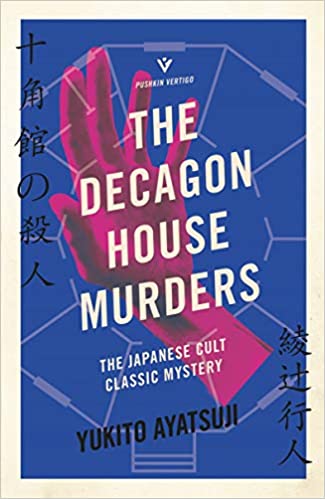Although a mystery should eventually make everything clear, it definitely should not belabor the obvious as if readers are numbskulls. Unfortunately, The Decagon House Murders does so several times. We’re only a few pages in when some members of a university mystery club are introduced and it’s clear that they are using the names of Golden Age mystery writers. But then the novel not only explains this but laboriously tells us who those writers are. Okay, I thought. It’s Japan. Maybe everyone wouldn’t know. But then, just a few pages later, a drawing of the floorplan of the Decagon House appears, labeled Figure 2, and then it is laboriously described—a description that adds nothing to the figure and “(See Figure 2)” is actually included. There are also several excruciating recaps of the clues, not to mention the four- or five-page explanation at the end of everything that happened.
So, here’s the setup. Some members of a university murder club are spending their spring break on an island where more than a year earlier there was a series of murders and the house was burned down, leaving only a utility building called the Decagon House (and an odd utility building it is). After the students depart for the island, some of their colleagues back on the mainland receive letters accusing them of murdering another club member, who died in a drinking party the year before. That person was the daughter of the family that was murdered on the island six months later. These two students, Kawaminami and Morisu, begin looking into the island murders by visiting the victim’s brother Nakamura Kōjirō, where they meet Shimada Kujoshi, a friend of Kōjirō.
The group on the mainland think they are pursing an intellectual mystery—a puzzle—but on the island, the murders have started with the death of Orczy, one of the two women, strangled in her sleep.
We won’t comment on the bad taste demonstrated by the selection of this venue for their meeting so soon after the death of the family. The novel had some surprises, or rather, it successfully led me up some blind alleys, pages and pages before the characters got there. It is interesting, though, that I noticed a Goodreads review claiming this is a “fair play” mystery—that it provides clues for the reader to get the solution. Actually, it hides a key relationship that would give away the motive until after the identity of the murderer is revealed.
The author’s bio claims this novel is a landmark book that revived the puzzle mystery in Japan when it was published in 1987. To me, it feels like a throwback to some of the more primitive efforts of the early 20th century. Anyway, I’m not sure the puzzle mystery needs to be revived.



I thought this was disappointing too. The characters never came to life for me and I found I didn’t really care about the solution. I’ve tried a few other Japanese puzzle mysteries and had the same problem, although I do like the ones by Seishi Yokomizo.
I only tried one other and had the same problem with it. Too complicated and the characters were indistinguishable.
Must admit I’ve found similar things whenever I’ve tried to read one of these Japanese attempts to revive the Golden Age-style mystery. I’d rather read an actual Golden Age mystery!
Me too.